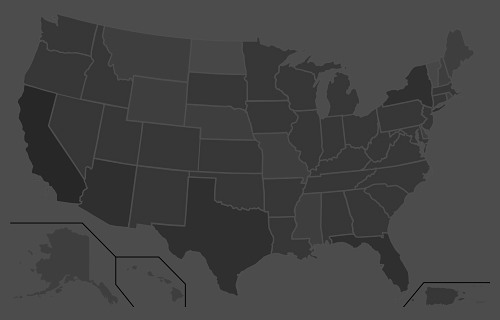“Our added winter moisture and active calling period led to a very long nesting and hatching season, starting in late April and extending into early summer, with chicks hatching as late as early July,” O’Dell said. “From a population standpoint, we are out of a deficit for the first time since 2001-2002. Quail are starting to pop up in places they haven’t been seen in a while.
“If you’ve never had the chance to experience what Arizona quail hunting built its name on, then this would be the year to get out and enjoy it.”
Meanwhile, hunters should note that the season for Mearns’ quail doesn’t begin until Dec. 4. It’s summer rainfall that plays a key role in nesting success and population numbers of this species. After a spotty and relatively weak monsoon across southern Arizona, these birds are likely to be abundant only in pockets that received sufficient precipitation this summer.
A valid Arizona hunting or combination hunt and fish license is required for all hunters 10 and older. Those hunters under 10 must either have a valid hunting or combination hunt and fish license, or be accompanied by an adult who possesses a valid hunting or combination hunt and fish license. Licenses can be purchased online or at license dealers statewide. A youth combination hunt and fish license (ages 10 to 17) is $5.
The general bag limit is 15 quail per day in the aggregate, of which no more than eight may be Mearns’ quail (when the Mearns’ season opens Dec. 4). The general possession limit is 45 quail in the aggregate after opening day, of which no more than 15 Gambel’s, scaled or California quail in the aggregate may be taken in any one day. After the opening of the Mearns’ season, the 45-quail possession limit may include 24 Mearns’ quail, of which no more than eight may be taken in any one day.
More quail-hunting information can be found on the department’s website at https://www.azgfd.com/Hunting/. Another resource for both new and experienced hunters alike is “An Introduction to Hunting Arizona’s Small Game.” Written by Randall D. Babb, the 196-page, full-color book covers where and how to hunt small game birds (like quail), squirrels, rabbits, ducks and geese. It also includes how to prepare and cook your harvest, with illustrations and recipes. The book can be ordered for $16.95 at www.azgfd.gov/publications.
Finally, hunters should check out O’Dell’s techniques for field-dressing quail at https://www.youtube.com/watch?v=3gRwZAcWzzk.
####
Publishers Notes: OUT OF STATE HUNTERS, FISHERMEN & OUTDOOR ENTHUSIASTS; Due to the Covid 19 pandemic, there could be limitations for OUT of STATE hunters, fishermen and other outdoor enthusiasts to include a 14-day quarantine requirement or negative COVID-19 testing alternative. Please check with the State's Department of Natural Resources BEFORE you travel or apply for the 2020 Fall Hunts.
Disclaimer: The views expressed on this site are that of the authors and not necessarily that of TBC Press
Wisconsin Schedules 2021 Wolf Harvest Season for February
Submitted by: TBC Press
Posted on: 02/17/21
The Backcountry Press
The country's premier daily HUNTING, FISHING & OUTDOOR news in the USA and around the globe. Read whats happening in your neck of the woods & beyond.
© 2020 TBC Press - All Rights Reserved Website Design by:
News # 14221
The DNR will post the updated rules and regulations for the February 2021 wolf harvest season on the wolf hunting and trapping webpage no later than Friday, Feb. 19. Printed copies will not be available in time for the February wolf harvest season.
Customers interested in applying for a harvest permit or preference point should note that the Go Wild website will be down for previously scheduled maintenance 2-6 a.m., Saturday, Feb. 20.
During the Natural Resources Board special meeting on Feb. 15, the board unanimously voted for a harvest quota of 200 wolves outside reservation lands.
The department's approved quota considered 2020 wolf population data, population response to previous harvest seasons, scientific literature, and population model projections. The proposed quota objective is to allow for a sustainable harvest that neither increases nor decreases the state's wolf population.
Before any licenses are issued, the DNR will take steps to honor the Ojibwe Tribes’ right to declare up to half of the harvestable surplus in the Ceded Territory, per the Tribes’ treaty rights and court rulings.
The U.S. Fish and Wildlife Service removed gray wolves from the federal endangered species list on Jan. 4, 2021, returning management authority to the lower 48 states and tribes. The Wisconsin DNR has successfully managed gray wolves for decades and will continue to do so under our state's laws and the best science available.
The DNR will continue to plan for a wolf harvest season to open on Nov. 6, 2021, while simultaneously working towards completing a 10-year wolf management plan to guide management decisions beginning in 2022.
For more on wolves in Wisconsin, visit the DNR website at https://dnr.wisconsin.gov/topic/hunt/wolf/index.html for additional information on wolf hunting and trapping, wolf management and wolf conflict abatement.
####
Publishers Notes: Our country is still battling COVID-19. To avoid the spread of this virus and continue to enjoy outdoor activities, ALL outdoor enthusiasts (man, woman, child) should follow the guidelines set by nps.gov. These guidelines include; social distancing, the Leave No Trace principles, including pack-in and pack-out, to keep outdoor spaces safe and healthy.
The Wisconsin Department of Natural Resources recently announced that a wolf harvest season will be Feb. 22-28, 2021.
All hunters and trappers interested in obtaining a wolf harvest permit or preference point must apply beginning at 12:01 a.m. Tuesday, Feb. 16. The application period will close at 11:59 p.m. on Saturday, Feb. 20. Customers may apply through their Go Wild account or by visiting a participating license agent. The application permit fee is $10 plus, $49 ($251 non-resident) for a wolf license if selected.
The DNR will post application results to each applicant’s Go Wild account the morning of Monday, Feb. 22. Customers may commence the harvest season once they secure their license and carcass/pelt tag.












